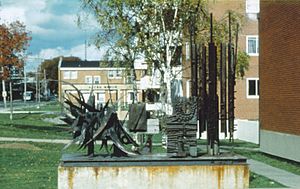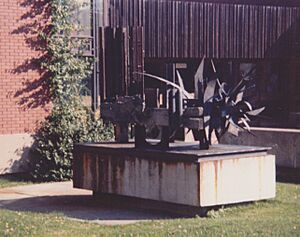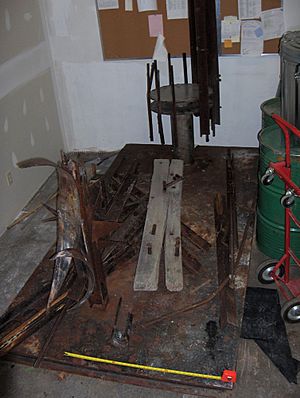Halifax Explosion Memorial Sculpture facts for kids
Quick facts for kids Halifax Explosion Memorial Sculpture |
|
|---|---|
 |
|
| Artist | Jordi Bonet |
| Year | 1966 |
| Type | Steel, Bronze, Wood |
| Dimensions | 3.0 m × 2.1 m × 4.6 m (10 ft × 7 ft × 15 ft) |
| Location | Halifax, Nova Scotia, Canada |
The Halifax Explosion Memorial Sculpture was a special piece of public art in Halifax, Nova Scotia. It was created in 1966 by a Quebec artist named Jordi Bonet. The sculpture was made to remember the terrible Halifax Explosion that happened many years before. It was placed at the Halifax North Memorial Library. Sadly, the sculpture was taken apart in 2004 and then accidentally lost or destroyed while it was being stored.
Remembering the Halifax Explosion
On December 6, 1917, a huge disaster struck Halifax Harbour. A French ship called the Mont-Blanc was carrying a lot of explosives. It accidentally blew up, causing a massive explosion. This terrible event killed almost 2,000 people and destroyed many parts of the city.
After the explosion, a group called the Halifax Relief Commission was formed. Their job was to help people recover and rebuild the city. In 1965, this group gave $100,000 to help build a new library. This library was in the North End of Halifax, which was hit very hard by the explosion. The library was meant to be a memorial to everyone who died.
The library was finished in 1966. As part of this new building, the architects asked artist Jordi Bonet to create an outdoor sculpture. Bonet was a sculptor from Spain who worked in Quebec. He was well-known for making public art that often had deep meanings. The sculpture was meant to remember the disaster and also show how the city was rebuilt and came back to life.
What the Sculpture Looked Like
The Halifax Explosion Memorial Sculpture was made from different materials. These included steel, iron, bronze, and wood. It was quite large, measuring about 15 feet tall and 7 feet wide. The sculpture had four main parts, each telling a different part of the story.
One part of the sculpture faced the street. It was a ball of sharp, curved steel blades. This part was meant to show the powerful and destructive force of the explosion. At its base, there was even a real piece from the Mont-Blanc ship itself.
Another part of the sculpture faced north. It used bronze and damaged wood to represent the human cost of the tragedy. This section included a bronze shape that looked like the outline of a doll. This doll symbolized the hundreds of children who sadly died in the explosion.
A third section faced south. It featured a damaged cogwheel, which represented industry and hard work. Next to it was a bronze casting of a flower, symbolizing new life and hope after the disaster.
The fourth part was closest to the library building. This section was a tall, round column made of many uniform steel rods. This part was designed to show the city being reborn and rebuilt after the explosion.
The Sculpture's Removal and Loss
Over more than 40 years, the sculpture was exposed to the weather. This caused some damage, and parts of it broke off. These damaged pieces were taken away and stored inside the library.
In 2004, the library underwent renovations, which included rebuilding its courtyard. During this time, the sculpture was taken apart. A new artwork called North is Freedom was put in its place. The city of Halifax said that the old sculpture couldn't be fixed and was a safety risk. So, it had to be stored while they decided what to do with it.
Unfortunately, the sculpture was broken into many pieces. These pieces were not labeled and were stored in different warehouses and city work yards. In 2006, a report suggested that the city should find all the parts and put them back together. However, this didn't happen. Several important parts of the sculpture went missing. This included the "doll" piece, which was the bronze casting representing the children who died. The fragment from the Mont-Blanc ship, which was part of the sculpture, was saved and is now at the Maritime Museum of the Atlantic.
In 2010, a group of artists and citizens formed a committee. They wanted the city to find the remaining pieces of the sculpture and check if it could be put back together. By the summer of 2011, the sculpture fragments were gathered in a secure city storage place. The committee continued to search for the missing bronze "doll."
The city's auditor, Larry Munroe, looked into what happened to the sculpture. He said it was worth about $90,000 to $100,000. Munroe found that all the parts had been together until 2008. Then, they were spread out, and many were lost, including the bronze doll. He said, "There has been quite a search but the missing piece has never been found. There is no hope it will be found." The auditor made several suggestions to prevent other artworks from being lost from the city's collection.
The citizen's committee had hoped that the remaining fragments of the sculpture could be fixed and put back on display. They wanted it to continue being a memorial in the North End of Halifax. However, in 2015, the city quietly sent the remaining pieces of the sculpture to the artist's family in Montreal. The final story of the sculpture only became known in 2018. This happened when people started asking questions about how the city stored its art, especially after another controversial statue was removed.



